|
|
|

TAIWAN'S NINE TRIBES: THE ORIGINAL PEOPLE
When I arrived in Taiwan just one year ago, I made it a point to contact
as many
people as possible who were in some way related to textiles: designers,
weavers,
museum people, academics, people in the textile industry, historians,
collectors,
dealers in historic textiles, researchers and so forth. When I mentioned
that I am a
handweaver and would like to learn about local handloom textile traditions,
I was
referred to the traditional weaving of Taiwan's minority tribes of
" original people",
the yuan zhu min.
I was given some books with excellent photographs, but the Chinese text
did not help
me much as I could not read Chinese characters. Furthermore, many of
the best early
documentation was done by Japanese ethnographers who worked here during
the
period of Japanese rule (1895-1945). These studies were published in
Japan and I'm
told that some of the finest collections of Taiwan aboriginal artifacts
are in Japanese
museums today. Nevertheless, efforts are being made here to preserve
some of the
artifacts of these cultures which are on the decline in the rapidly
developing,
fast-moving, urbanizing , globalizing society of modern Taiwan.
The "original people" now constitute less then 2% of the island's population
(roughly
400,000, out of a total population in Taiwan of 21.5 million). There
are nine major
tribal groups recognized today: Atayal, Saisiat, Bunun, Tsou, Paiwan,
Rukai, Puyauma,
Ami, all of whom live in the mountainous central and eastern regions
of Taiwan, plus
the tiny community of Yami who live on isolated Orchid Island. At one
time the Han
Chinese inhabitants referred to all of them as shan di ren, "mountain
people," or
"highlanders" because they retreated to the higher mountains as the
Han Chinese came
in over the centuries to settle and farm the richer lowlands.
From the nearest point on the island of Taiwan it is barely one hundred
miles across
the Taiwan Strait to Fujian Province on the mainland of China, yet
the yuan zhu min
probably did not come from there, but more likely hailed from the sea-going
Pacific
Island cultures of Austronesian origin. There is a school of thought
that some of the
tribal groups did come from minority groups still living on mainland
China, but much
of the lingisustic and cultural evidence, including weaving technology,
points
elsewhere. Just how they came here, when and from where remains something
of a
mystery. Apparently, archaeological excavations reveal the presence
of people on the
island as long as fifteen thousand years ago, but whether or not they
were related to the
present tribal people is not known. Physically and culturally, the
yuan zhu min were
very different from the Han Chinese settlers. Inevitably, some of the
lowland groups
assimilated, while others were pushed into more isolated locations,
including the
central mountains, where their hunting and gathering way of life, combined
with their
simple forms of agriculture, would not compete with that of the newcomers.
GRANDMOTHER WEAVER OF THE BUNUN TRIBE
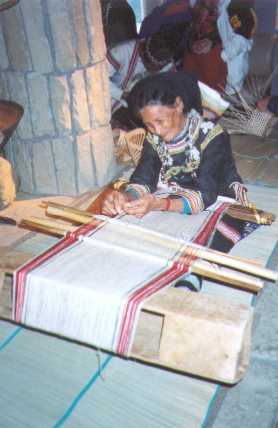
In the first few months of our stay in Taiwan, I collected as much information
as I
could from books, visits to museums, visits to various tribal culture
centers, meetings
with local leaders, aboriginal legislators and craftsmen. In October,
I finally had a
chance to meet with a group of traditional tribal weavers from up on
Ali Shan,
Taiwan's second-highest mountain. The occasion was a demonstration
of Bunun
weaving held in the Ta-Ta-Chia Center, a musem and activity center
in a national park
half way up the mountain.
The most important member of the Bunun group was simply referred to
as
"Grandmother" by all present. She is a ninety-something year old woman
with a
twinkle in her eyes and wonderful hands, and a peaceful, friendly,
quiet demeanor. She
is known to be the oldest living tribal weaver in Taiwan, and the last
of her kind who
has mastered the intricacies of "the twelve bamboo sticks" weaving
method. She was
accompanied by her grand-daughter Ku-Siu-Hung, who has learned some,
but not all of
the old techniques and was demonstrating them on her own loom. The
grandaughter is
also teaching young women and children in the village how to weave
and is starting to
supply a few woven souvenir items to the handicraft market.
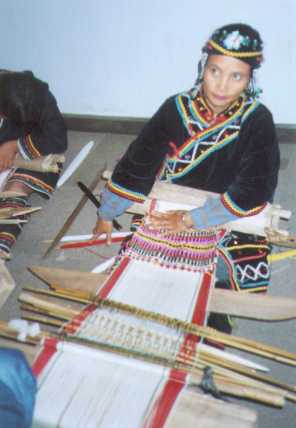
We arrived at the center barely half an hour before the demonstration
was scheduled to
end and the group to depart for the upper reaches of Ali Shan. This
day the group had
walked from their village for two hours, then ridden in a bus for three
hours down the
rough and winding mountain roads, which made them sick, and so they
were anxious to
get the homeward journey over with. They declared that they disliked
riding in busses
or cars and much preferred to walk! Even better would be to stay home
and weave!
Luckily for us, they delayed their departure a little and spent some
extra time with us.
Then after they left, we stayed on to study the displays of weavings,
implements and
information about techniques (which, however, was mainly written in
Chinese
characters and therefore of limited utility to us).
The looms used by these women and those of all the other tribal people
I have seen
here, are a form of horizontal back-strap loom, with the weaving started
at the end of
the warp closest to the weaver's body. This type consists of a belt
which goes around
the weaver's back at the waist and is connected to the cloth beam;
a warp beam at the
opposite end of the warp; a lace rod which helps prevent the warp threads
from
tangling; a heddle rod for raising sets of warps and creating the shed
for the passage of
the weft; shed sticks which help to form wheds and counter sheds; a
shuttle or spool
and a shed sword or beater, for packing the weft into place. In this
case the warp beam
takes the form of an elongated box. The weaver controls the tension
on the warp by
pushing this box-like warp beam with her feet rather than anchoring
it to a fixed point
(like a hook or house post) and leaning the body back to create tension
from the
harness tied around the waist. The warp is a continuous, circular warp
wound on a
warping bench called garasajan . It consists of several sticks which
can be fitted into
a grid of holes drilled into half of a log. There seem to be several
arrangements for
warping using different holes. Presumably the length of the warp is
limited by the
distance between the particular weaver's feet and waist. Evidently
there is some
affinity between the looms with the movable warp beam and looms used
in other
places in South East Asia among the Angami Naga of Assam, the Li and
the Ch'I of
Hainan, and the Muong of Indochina.* 1.
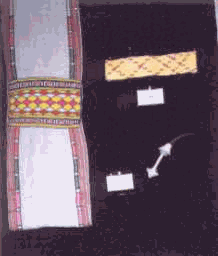
I was told that the weave structure is determined by the order in which
the warp thread
is wrapped around the sticks. As far as I can tell, plain weave and
a simple 1 by 2
twill are woven in this way, sometimes with a pickup inlay design added
at will.
Among the weaving implements on display was a tool which is a wooden
spool with a
thin claw attached. I have never before seen such a tool, but surmise
that it might be
very useful in doing the individual pick-up designs.
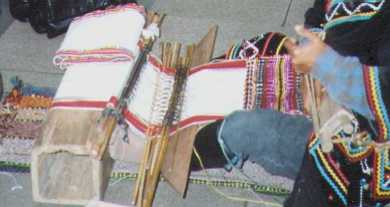
More complicated is the twelve bamboo sticks which creates a supplementary
set of
lift pattern heddle sticks. Complex weaves with sticks! This technique
is somewhat
familiar to me as it looks similar to the one used on my back strap
loom from the tribal
areas of Manipur and Nagaland in India. In those cases, the supplementary
pattern
sticks with wound thread heddles are used only in the center stripe
of the cloth when
the pattern is needed, whereas the Bunun arrangement covers the entire
width of the
cloth.

In my notes from the visit to Ali Shan, I noted that the granddaughter
was using a
heddle system of two sets of conventional heddle sticks with string
heddles, and
further up the warp sets of pickup pattern sticks (in pairs) without
string heddles. (This
seems strange and unlikely to me, but I was not able to open the sticks
and take a good
look at how it works.) In some of the publications I have since read
and exhibitions I
have seen, weaving produced with this arrangement has apparently been
designated as
"in-woven pattern", or "Paiwan Jacquard" (named for the Paiwan people,
one of the
other tribes of Taiwan). It seems to me that neither name fits exactly
; it is neither
produced on a draw loom nor on what we know as the Jacquard loom, which
operates
with punch cards and weighted warps. In my view, "supplementary weft
inlay " sounds
more accurate. But if anyone has a better name for this kind of weaving,
I would
welcome suggestions.
Traditionally, all of the Taiwan aboriginal tribal groups used finely
spun and bleached
or naturally dyed ramie fiber for their weaving. The raising, processing
and spinning
of this fiber is extremely time consuming and labor intensive. More
recently, cotton
warps and florescent colored acrylic yarns have made inroads into the
traditional
palette with not always attractive results. Most of the older samples
of Bunun weaving
on display at the Ali Shan Center were woven in the bleached ramie
yarn in twills or
plain weave, possibly some areas of a stin weave ,with inlays of vegetable
and
mineral dyed supplimentary wefts. ( Some of the old pieces were done
in white on
white textural horizontal stripes of opposing right hand and left hand
twills, sometimes
with a contrasting panel of satin weave, it did not appear to be plain
weave). For dye
colors the "old timers" got black from black earth, red from the sap
of a tree with a red
inner core, yellow from a turmeric-like rhizome, and green from an
unspecified green
plant. (I do not yet have botanical names for these plants and convey
the information to
you as it was told to me; on the weaving questions, I had to work through
an interpreter
who was not a weaver, so some of the details may be imprecise.)
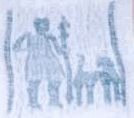
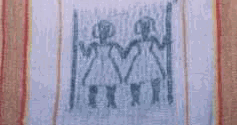
There was a display of old weavings done by "Grandmother Weaver" in
her youth. My
favorite was a shawl she had woven for her father in white ramie with
blue gray
figures of a man( perhaps her father) shouldering a spear beside a
dog, obviously they
were setting off on a hunting trip. The next motif is two little girls
hnad in hand,
perhaps the weaver and her sister bidding their father farewell and
wishing him
success in the hunt. In one of the upland culture centers I later visited,
I heard a group
of old men of another tribe sing a peculiar and haunting song. It was
meant to be sung
by the huntsmen after the hunt on their way home. It was performed
in a tight , low,
circle, with voices concentrated in the center while the men moved
slowly in a circle.
Rather than a lyrical song, it was more of a chant without words but
using a form of
voice production which would carry across the mountain ridges. Through
the pulsing
crescendo, the arying tempo, volume and tone of the performance, the
women waiting
in the village could tell that thehunters were on their way home, that
ass was well ( or
not well, as the case may be) and that the hunt was successful ( or
possibly not
successful).
In a few remote corners of this beautiful island, a little hunting and
farming in the old
way is carried on, and a precious few pieces of traditional weaving
grows out of
skilled hands and a few sticks and fibers. But that life-style is quickly
fading and the
population in the villages is dwindling. New technical schools have
set up for the
children of the "Original People", they are seeking work in the cities,
participating in
the politcal process of the new democracy and sharing in the dreams
of prosperity and
modernity in the new Taiwan. What we are left with is too few pieces
of beautifully
woven or embroidered cloth, some wood carvings and pottery, some stories,
songs,
memories--- and many questions.
*1. Chen Chi-lu, Material Culture of the Formosan Aborigines, Southern
Materials
Center, Inc., Taipei, 1968, pp.100-103
Questions, comments, relevant additional information
to
kjohnson@mail.ait.org.tw